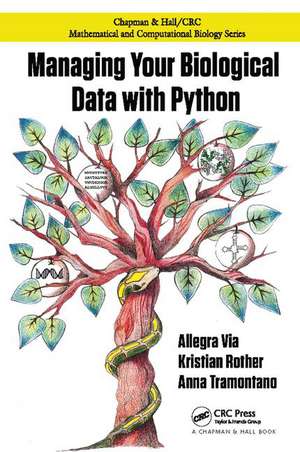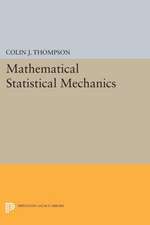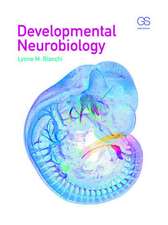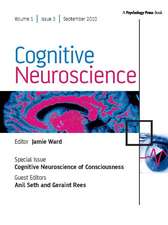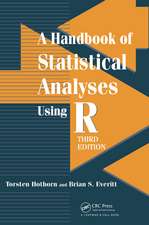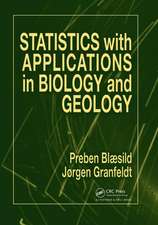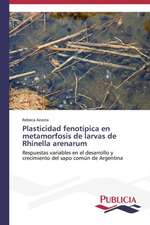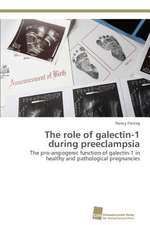Managing Your Biological Data with Python: Chapman & Hall/CRC Computational Biology Series
Autor Allegra Via, Kristian Rother, Anna Tramontanoen Limba Engleză Hardback – 21 aug 2017
Din seria Chapman & Hall/CRC Computational Biology Series
-
 Preț: 361.62 lei
Preț: 361.62 lei - 9%
 Preț: 643.23 lei
Preț: 643.23 lei - 20%
 Preț: 389.57 lei
Preț: 389.57 lei -
 Preț: 357.23 lei
Preț: 357.23 lei -
 Preț: 357.98 lei
Preț: 357.98 lei -
 Preț: 357.70 lei
Preț: 357.70 lei -
 Preț: 357.17 lei
Preț: 357.17 lei - 9%
 Preț: 688.53 lei
Preț: 688.53 lei -
 Preț: 350.06 lei
Preț: 350.06 lei - 8%
 Preț: 528.22 lei
Preț: 528.22 lei - 20%
 Preț: 526.41 lei
Preț: 526.41 lei - 8%
 Preț: 407.02 lei
Preț: 407.02 lei -
 Preț: 370.11 lei
Preț: 370.11 lei - 8%
 Preț: 461.00 lei
Preț: 461.00 lei - 15%
 Preț: 699.14 lei
Preț: 699.14 lei - 22%
 Preț: 376.15 lei
Preț: 376.15 lei - 12%
 Preț: 305.97 lei
Preț: 305.97 lei -
 Preț: 422.44 lei
Preț: 422.44 lei - 5%
 Preț: 301.09 lei
Preț: 301.09 lei - 24%
 Preț: 702.77 lei
Preț: 702.77 lei - 15%
 Preț: 469.19 lei
Preț: 469.19 lei - 24%
 Preț: 512.37 lei
Preț: 512.37 lei - 15%
 Preț: 534.18 lei
Preț: 534.18 lei -
 Preț: 434.25 lei
Preț: 434.25 lei - 27%
 Preț: 529.77 lei
Preț: 529.77 lei -
 Preț: 455.01 lei
Preț: 455.01 lei - 18%
 Preț: 786.86 lei
Preț: 786.86 lei - 15%
 Preț: 468.17 lei
Preț: 468.17 lei - 15%
 Preț: 511.05 lei
Preț: 511.05 lei -
 Preț: 421.63 lei
Preț: 421.63 lei - 21%
 Preț: 1023.71 lei
Preț: 1023.71 lei - 25%
 Preț: 852.72 lei
Preț: 852.72 lei - 8%
 Preț: 305.97 lei
Preț: 305.97 lei - 24%
 Preț: 460.87 lei
Preț: 460.87 lei - 15%
 Preț: 557.60 lei
Preț: 557.60 lei - 15%
 Preț: 556.77 lei
Preț: 556.77 lei
Preț: 986.91 lei
Preț vechi: 1328.88 lei
-26% Nou
Puncte Express: 1480
Preț estimativ în valută:
188.87€ • 205.08$ • 158.65£
188.87€ • 205.08$ • 158.65£
Carte tipărită la comandă
Livrare economică 22 aprilie-06 mai
Preluare comenzi: 021 569.72.76
Specificații
ISBN-13: 9781138407220
ISBN-10: 1138407224
Pagini: 560
Dimensiuni: 156 x 234 x 38 mm
Greutate: 0.45 kg
Ediția:1
Editura: CRC Press
Colecția Chapman and Hall/CRC
Seria Chapman & Hall/CRC Computational Biology Series
ISBN-10: 1138407224
Pagini: 560
Dimensiuni: 156 x 234 x 38 mm
Greutate: 0.45 kg
Ediția:1
Editura: CRC Press
Colecția Chapman and Hall/CRC
Seria Chapman & Hall/CRC Computational Biology Series
Public țintă
Academic and Professional Practice & DevelopmentRecenzii
“… a significant step forward … The book is cleverly designed to cover a wide range of subjects in a pleasant, easy-to-follow sequence of chapters. These have been carefully prepared so that the minimum level of interdependence is kept, making it possible to begin working at virtually any level without falling into intricate cross-references. A beginner will find the first chapters quite welcoming while a person with medium or even high levels of programming experience can easily find a suitable entry point in the middle.
The book is written using an entertaining style that pushes the reader into a naturally built engaging experience … the authors have chosen a collection of underlying subject areas that cover a very wide variety of interests, ensuring that mixed audiences are kept engaged. In that sense, the content becomes adaptable to the wide diversity of learners that are found in today's communities of specialised biologists.
… also usable as a reference guide, due to the richness of its worked examples that will prove valuable as seeds for code development for programmers at any level. … as a single book to support learning Python for problem solvers in the life sciences, this book is certainly a very smart choice. It is also ready for creative teachers to develop more in the same direction.”
—Pedro L. Fernandes, Instituto Gulbenkian de Ciência
"Having read Managing Your Biological Data with Python brings back memories of the times I started writing my first lines of code nearly a decade ago. As a beginning structural biologist without any coding experience, this book would have been a welcome companion to quickly get me started on my bioinformatical projects with Python. It is this, often pragmatic, attitude scientists have towards programming that makes Python the language of choice for many. A clear syntax, powerful build-in functions and a lively ecosystem of user contributed modules allow you to do advanced things with only little lines of code.
The book introduces you to the basic principles of programming in Python using the many build-in functions. It does so using practical examples that you can start using right away in your day-to-day research.
Python’s modular design principles could even be seen in the organization of this book. If you have never written a line of code in your life, the first chapters are indispensable to teach you basic coding principles but if you have some experience, you can safely skip these. I would however, recommend to read the ones introducing the build-in functions. It never hurts to refresh your memory on the many powerful build-ins Python actually has; I certainly forgot about one or two of them. Working your way through the first chapters will help you get comfortable with Python and lay the foundation for writing more advanced programs in the remaining chapters. These chapters introduce some of the powerful community contributed Python modules that make your life as a biologist a whole lot easier. Again, the example code introducing these modules is of high practical value and together with the coding recipes in the ‘cookbook’ chapter they provide a solid blueprint for you to build your own code upon.
I’m confident that reading Managing Your Biological Data with Python will quickly allow you to get the most out of your data and start answering those trilling scientific questions you have, and do all of that while having fun. "
—Marc van Dijk, Structural biologist, bioinformaticien, and eScience entrepreneur, Bijvoet Center for Biomolecular Research, Utrecht University, The Netherlands
"For many biologists faced with computational challenges, Python has become the language of choice, due to its power, elegance, and simplicity. Managing Your Biological Data with Python by Allegra Via et al. teaches Python using biological examples and discusses important Python-driven applications, such as PyMol and Biopython. The book is an excellent resource for any biologist needing relevant programming skills."
—Thomas Hamelryck, Associate Professor, Bioinformatics Center, University of Copenhagen, Denmark
"Biological data volumes are growing rapidly as high-throughput technologies (e.g., DNA microarrays or DNA/RNA sequencing) improve. Managing and analyzing biological data are becoming more demanding and the application of programming techniques has simply become a standard. Managing Your Biological Data with Python is one of very few user-friendly books for biologists. It is amazing how clearly authors explain the possible applications of Python for data management (parsing data records, filtering and sorting data) and data visualization (also using the Python interface to R). The book also offers the description of modular programming, which is simply excellent! It guides readers from writing simple functions through writing classes to building program pipelines—everything according to Python coding standards and in an easy-to-follow way. This is absolutely the best book to start learning Python. Intermediate Python users can use this book to learn some new tricks that they could implement in their own code. I can highly recommend this book to researchers, students, and their lecturers."
—Dr. Barbara Uszczynska, Centre de Regulació Genòmica (CRG), Barcelona, Spain
The book is written using an entertaining style that pushes the reader into a naturally built engaging experience … the authors have chosen a collection of underlying subject areas that cover a very wide variety of interests, ensuring that mixed audiences are kept engaged. In that sense, the content becomes adaptable to the wide diversity of learners that are found in today's communities of specialised biologists.
… also usable as a reference guide, due to the richness of its worked examples that will prove valuable as seeds for code development for programmers at any level. … as a single book to support learning Python for problem solvers in the life sciences, this book is certainly a very smart choice. It is also ready for creative teachers to develop more in the same direction.”
—Pedro L. Fernandes, Instituto Gulbenkian de Ciência
"Having read Managing Your Biological Data with Python brings back memories of the times I started writing my first lines of code nearly a decade ago. As a beginning structural biologist without any coding experience, this book would have been a welcome companion to quickly get me started on my bioinformatical projects with Python. It is this, often pragmatic, attitude scientists have towards programming that makes Python the language of choice for many. A clear syntax, powerful build-in functions and a lively ecosystem of user contributed modules allow you to do advanced things with only little lines of code.
The book introduces you to the basic principles of programming in Python using the many build-in functions. It does so using practical examples that you can start using right away in your day-to-day research.
Python’s modular design principles could even be seen in the organization of this book. If you have never written a line of code in your life, the first chapters are indispensable to teach you basic coding principles but if you have some experience, you can safely skip these. I would however, recommend to read the ones introducing the build-in functions. It never hurts to refresh your memory on the many powerful build-ins Python actually has; I certainly forgot about one or two of them. Working your way through the first chapters will help you get comfortable with Python and lay the foundation for writing more advanced programs in the remaining chapters. These chapters introduce some of the powerful community contributed Python modules that make your life as a biologist a whole lot easier. Again, the example code introducing these modules is of high practical value and together with the coding recipes in the ‘cookbook’ chapter they provide a solid blueprint for you to build your own code upon.
I’m confident that reading Managing Your Biological Data with Python will quickly allow you to get the most out of your data and start answering those trilling scientific questions you have, and do all of that while having fun. "
—Marc van Dijk, Structural biologist, bioinformaticien, and eScience entrepreneur, Bijvoet Center for Biomolecular Research, Utrecht University, The Netherlands
"For many biologists faced with computational challenges, Python has become the language of choice, due to its power, elegance, and simplicity. Managing Your Biological Data with Python by Allegra Via et al. teaches Python using biological examples and discusses important Python-driven applications, such as PyMol and Biopython. The book is an excellent resource for any biologist needing relevant programming skills."
—Thomas Hamelryck, Associate Professor, Bioinformatics Center, University of Copenhagen, Denmark
"Biological data volumes are growing rapidly as high-throughput technologies (e.g., DNA microarrays or DNA/RNA sequencing) improve. Managing and analyzing biological data are becoming more demanding and the application of programming techniques has simply become a standard. Managing Your Biological Data with Python is one of very few user-friendly books for biologists. It is amazing how clearly authors explain the possible applications of Python for data management (parsing data records, filtering and sorting data) and data visualization (also using the Python interface to R). The book also offers the description of modular programming, which is simply excellent! It guides readers from writing simple functions through writing classes to building program pipelines—everything according to Python coding standards and in an easy-to-follow way. This is absolutely the best book to start learning Python. Intermediate Python users can use this book to learn some new tricks that they could implement in their own code. I can highly recommend this book to researchers, students, and their lecturers."
—Dr. Barbara Uszczynska, Centre de Regulació Genòmica (CRG), Barcelona, Spain
Cuprins
Getting Started: The Python Shell. Your First Python Program. Data Management: Analyzing a Data Column. Parsing Data Records. Searching Data. Filtering Data. Managing Tabular Data. Sorting Data. Pattern Matching and Text Mining. Modular Programming: Divide a Program into Functions. Managing Complexity with Classes. Debugging. Using External Modules: The Python Interface to R. Building Program Pipelines. Writing Good Programs. Data Visualization: Creating Scientific Diagrams. Creating Molecule Images with PyMOL. Manipulating Images. Biopython: Working with Sequence Data. Retrieving Data from Web Resources. Working with 3D Structure Data. Cookbook. Appendices.
Notă biografică
Allegra Via, Kristian Rother, Anna Tramontano
